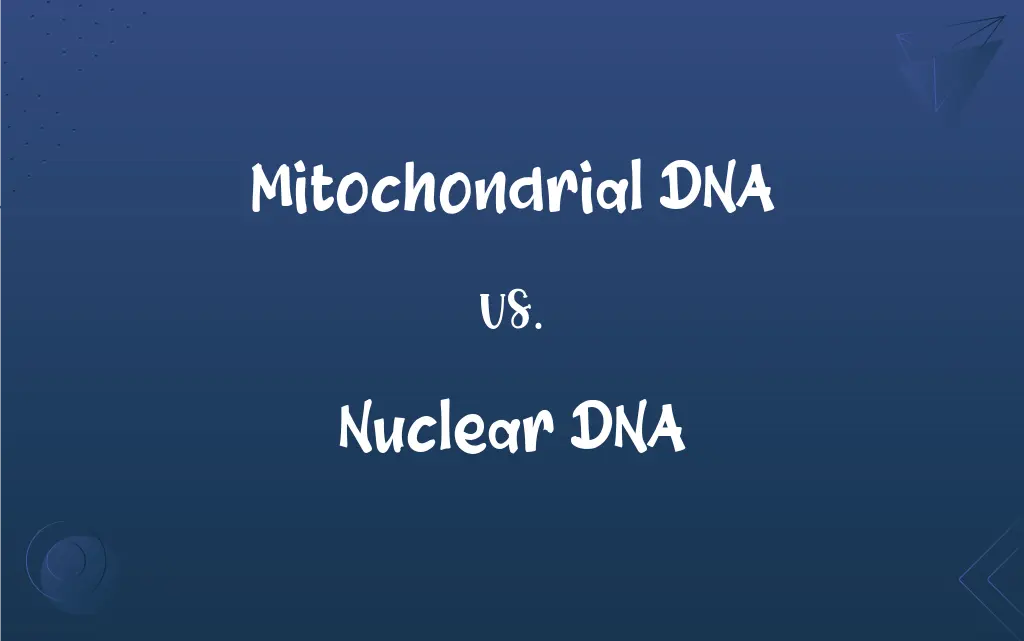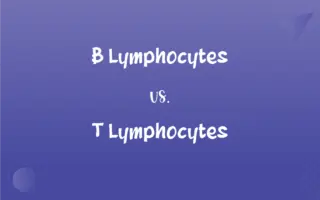Mitochondrial DNA vs. Nuclear DNA: What's the Difference?
Edited by Janet White || By Harlon Moss || Updated on June 6, 2024
Mitochondrial DNA is inherited maternally and resides in the mitochondria, while nuclear DNA is found in the cell nucleus and inherited from both parents.

Key Differences
Mitochondrial DNA (mtDNA) is found in the mitochondria, the energy-producing structures within cells. Nuclear DNA (nDNA), on the other hand, resides in the cell nucleus. The mtDNA is crucial for generating energy, while nDNA contains the majority of the genetic instructions used in the development and functioning of all living organisms.
Mitochondrial DNA is distinct as it is primarily inherited from the mother, often used to track maternal lineage. In contrast, nuclear DNA is a combination of both parental DNA, encapsulating genetic information from both the mother and the father. Thus, the inheritance patterns of mtDNA and nDNA are quite different and utilized in diverse genetic studies and applications.
Mitochondrial DNA is relatively small, comprising approximately 16,000 DNA bases, and it has a high mutation rate. Conversely, nuclear DNA is significantly larger, with about 3 billion bases, and generally has a lower mutation rate. Hence, mtDNA and nDNA exhibit differences not only in location but also in size and stability.
Mitochondrial DNA is involved in processes related to energy production in the cell and is crucial for cellular function. Nuclear DNA plays a fundamental role in creating an organism’s entire genetic blueprint, directing growth, development, and maintenance of the organism. Thus, despite being DNA, their roles and impacts within an organism are distinctly disparate.
In research and forensics, mitochondrial DNA is often used for tracing maternal ancestry and for species identification due to its high mutation rate and maternal inheritance. Nuclear DNA is pivotal in understanding complex genetic relationships, determining paternity, and solving crimes by providing comprehensive genetic profiles through techniques like DNA fingerprinting. Consequently, mtDNA and nDNA hold individual significance and application in scientific research and forensic studies.
ADVERTISEMENT
Comparison Chart
Location
Located in the mitochondria of the cell
Located in the cell nucleus
Size
Approximately 16,500 bases in humans
Approximately 3 billion bases in humans
Inheritance
Maternally inherited
Inherited from both parents
Mutation Rate
High mutation rate
Relatively low mutation rate
Function
Involved in cellular energy production
Encodes the majority of the genetic blueprint
ADVERTISEMENT
Mitochondrial DNA and Nuclear DNA Definitions
Mitochondrial DNA
Mitochondrial DNA has a notably higher mutation rate compared to nuclear DNA.
The high mutation rate of mitochondrial DNA allows scientists to trace evolutionary changes.
Nuclear DNA
Nuclear DNA encodes the majority of the genetic information required for the structure, function, and regulation of an organism's cells.
Geneticists study nuclear DNA to understand genetic diseases and their inheritance patterns.
Mitochondrial DNA
Mitochondrial DNA is a small circular genome located within the mitochondria of a cell.
Scientists often study mitochondrial DNA to understand maternal ancestry.
Nuclear DNA
Nuclear DNA has a relatively stable and low mutation rate compared to mitochondrial DNA.
Due to the stability of nuclear DNA, it is used to understand long-term genetic evolution.
Mitochondrial DNA
Mitochondrial DNA encodes genes vital for the mitochondria’s function, primarily related to energy production.
Defects in mitochondrial DNA can affect cellular energy production and overall cellular function.
Nuclear DNA
Nuclear DNA plays a pivotal role in forensic investigations due to its ability to uniquely identify individuals.
In criminal investigations, nuclear DNA from a crime scene can be matched to a suspect’s DNA profile.
Mitochondrial DNA
Mitochondrial DNA is exclusively inherited along the maternal line.
Your mitochondrial DNA provides information about your maternal lineage.
Nuclear DNA
Nuclear DNA is the genetic material found in the nucleus of a cell.
Every cell in your body, except red blood cells, contains nuclear DNA.
Mitochondrial DNA
Mitochondrial DNA can be used in forensic science due to its presence in hair shafts and durability outside the body.
Investigators utilized mitochondrial DNA to link hair found at a crime scene to a suspect.
Nuclear DNA
Nuclear DNA is inherited from both parents, combining genes from both the maternal and paternal lines.
Your nuclear DNA is a mixture of genes passed down from your mother and father.
FAQs
Where is nuclear DNA found?
Nuclear DNA is located in the cell nucleus, containing the majority of an organism's genetic information.
How is mitochondrial DNA inherited?
Mitochondrial DNA is inherited maternally, meaning it is passed down from mother to offspring.
Why is mitochondrial DNA useful in genetic research?
Its high mutation rate and maternal inheritance make mitochondrial DNA useful for tracing maternal lineage and studying evolutionary history.
Why does mitochondrial DNA have a higher mutation rate than nuclear DNA?
It's partly due to its proximity to the electron transport chain (a source of reactive oxygen species) and lack of protective histones, which nuclear DNA has.
Can mitochondrial DNA provide insights into human evolution?
Absolutely, scientists study mitochondrial DNA to trace human evolutionary paths and understand human migration patterns.
How can nuclear DNA testing assist in paternity cases?
Nuclear DNA testing compares the DNA of a child to potential parents, determining biological relationships and confirming paternity.
Who contributes to the nuclear DNA in an individual?
Nuclear DNA is inherited from both parents, combining genetic information from each.
Can mutations in nuclear DNA be harmful?
Yes, mutations in nuclear DNA can be benign or cause conditions like genetic disorders, contributing to diseases like cancer.
Can nuclear DNA provide information about specific traits?
Yes, nuclear DNA encodes most genetic instructions, affecting an individual’s traits, susceptibility to diseases, and more.
What is the size of mitochondrial DNA?
Mitochondrial DNA is relatively small, consisting of approximately 16,500 DNA bases in humans.
What kind of genes are encoded by nuclear DNA?
Nuclear DNA encodes genes that govern the majority of bodily functions, structures, and regulations, influencing various traits and characteristics.
Is mitochondrial DNA present in all cells?
Mitochondrial DNA is present in most cells, except for some like mature red blood cells, which lack mitochondria.
What is mitochondrial DNA?
Mitochondrial DNA is a small, circular DNA found in the mitochondria of cells, crucial for cellular energy production.
How large is the nuclear DNA?
Nuclear DNA is substantial, with approximately 3 billion bases in the human genome.
What is the role of nuclear DNA in reproduction?
Nuclear DNA combines genes from both parents during reproduction, contributing to the genetic variability and traits of the offspring.
Can mitochondrial DNA identify species?
Yes, mitochondrial DNA can be utilized to identify species and understand interspecies relationships due to its evolutionary tracking capabilities.
Why is nuclear DNA crucial in forensics?
Nuclear DNA can uniquely identify individuals, making it vital in forensic science for solving crimes and identifying bodies.
Does mitochondrial DNA affect cellular function?
Yes, mutations or defects in mitochondrial DNA can disrupt cellular energy production, affecting cell functionality and health.
Are mitochondrial DNA tests available for ancestry tracking?
Yes, mitochondrial DNA tests are available and commonly used to trace maternal ancestry and understand maternal lineage migrations.
How is nuclear DNA used in medical research?
Nuclear DNA is studied to understand genetic disorders, discover potential treatments, and explore the genetic basis of diseases.
About Author
Written by
Harlon MossHarlon is a seasoned quality moderator and accomplished content writer for Difference Wiki. An alumnus of the prestigious University of California, he earned his degree in Computer Science. Leveraging his academic background, Harlon brings a meticulous and informed perspective to his work, ensuring content accuracy and excellence.
Edited by
Janet WhiteJanet White has been an esteemed writer and blogger for Difference Wiki. Holding a Master's degree in Science and Medical Journalism from the prestigious Boston University, she has consistently demonstrated her expertise and passion for her field. When she's not immersed in her work, Janet relishes her time exercising, delving into a good book, and cherishing moments with friends and family.































































